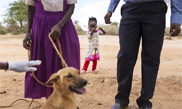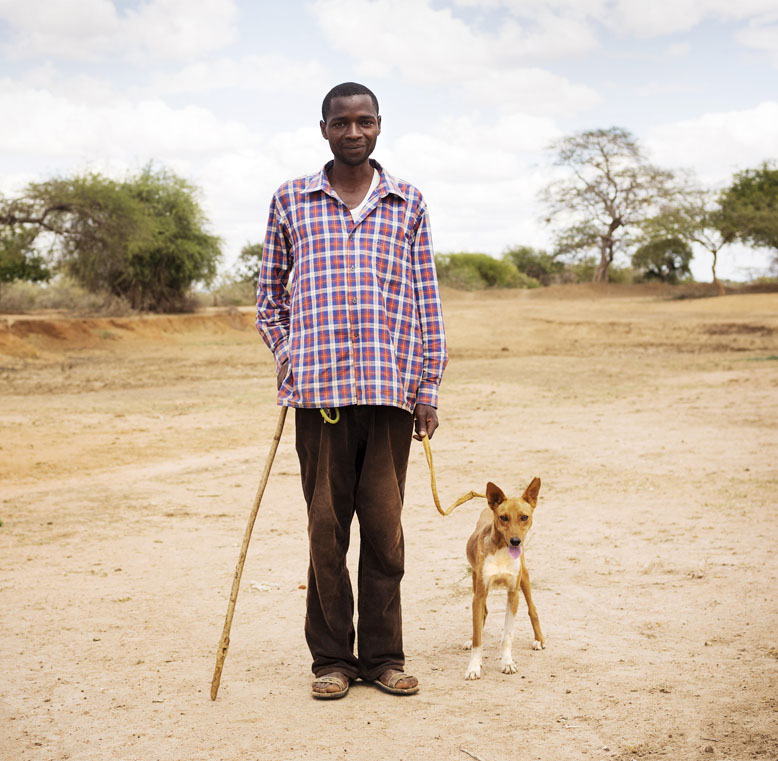Story at a glance
-
Long Walk Towards Rabies Eradication
Local youth lead the way
-
Vaccination Drives
Working towards eradication
-
Face-to-Face with Rabies
Fighting to end the scourage
-
Unfinished Business
Remaining vigilant against a resilient disease
A trio of lithe canines throw up a cloud of dust as it bolts through the village, heading for the shade of a knot of trees. In hot pursuit is a group of small children, keeping pace and yelling to one another as they steer these dogs to their appointment with the veterinarian.
In their fight against rabies, the veterinary professionals of Makueni County, Kenya have tapped the most enthusiastic, energetic and abundant resource around – local kids.
Dogs are primarily outdoor pets in this remote area, accessible by a single road some three hours’ drive from Nairobi. The children here know each and every dog, their habits and their hiding places, and so it’s their job to round them up on vaccination day.
The slightly chaotic scene at the vaccination station is not unlike an exuberant village get-together. Pockets of people, barking dogs and high-spirited children are punctuated by the calm presence of the veterinarianerinarian, who moves from canine to canine administering vaccinations.
On completion, each owner receives a certificate with a reminder that their pet’s booster is due next year.
There’s a sense of poetic justice in mobilising children in the efforts to beat a disease that disproportionately impacts the young. Some 40 percent of rabies victims around the world are under 15, placing huge emotional and economic hardship on communities as their young people are lost to this entirely preventable disease.
Vaccination Drives
The first activity we will do in a community is publicity around the vaccination. We target schools because it’s mostly children who are dog owners, so if we advertise in schools, we’ll get bigger numbers coming with their dogs.”
Ogonji Humphrey,VeterinarianWorking towards eradication
Dr Ogonji Humphrey is just one of the veterinarians who together make up a grassroots movement tackling rabies in Kenya.
“The first activity we will do in a community is publicity around the vaccination,” he explains, as he packs up his van after the vaccination drive is complete.
“We target schools because it’s mostly children who are dog owners, so if we advertise in schools, we’ll get bigger numbers coming with their dogs.”
What comes next is a rigorously-planned exercise to vaccinate as many dogs as possible, as Dr Humphrey explains.
“We deploy people to the different vaccination sites, and there’ll be a supervision team checking what everyone is doing at their station and that they have supplies – if they’re overwhelmed by the number of dogs, we will assist them.”
After a day of vaccination in the baking sun, the team compiles reports from each of the vaccination stations to see if a target to vaccinate 70 percent of dogs in the locality has been met (it’s at this point that ‘herd immunity’ is reached in the canine population).
“Then, we use the learnings from the report to plan for the next exercise,” says Dr Humphrey.
We deploy people to the different vaccination sites, and there’ll be a supervision team checking what everyone is doing at their station and that they have supplies.”
Ogonji Humphrey, VeterinarianMore than 120 countries around the world are still affected by canine rabies (despite the availability of a vaccine for more than a century). This is a disease of poverty, with more than 95 percent of the world’s 59,000 human deaths each year concentrated in Africa and Asia.
And so cost-effective methods of fighting this disease, like the vaccination of dogs – both cheaper and more effective than human treatments – are sorely needed.
In targeting the canine population, Dr Humphrey and his team are trying to stamp out rabies at source. Dogs are thought to contribute up to 99 percent of all transmission to humans.
Face-to-Face with Rabies
Fighting to end the scourage
The devastating impact of this transmission may be almost forgotten across Europe and the Americas where human rabies has been largely eliminated, but it is all too present for Daniel Kisee, a veterinarian with the government of Makueni County.
“When someone has rabies, they salivate uncontrollably and are unable to swallow it, or swallow water … they’re not able to communicate,” he explains.
“They become aggressive, just like a rabid animal, and they want to bite other people – in fact in a hospital ward they are normally restrained. Then they go into a coma and eventually die … it must be very painful.”
If this makes for difficult reading, then it’s all the more so when we consider just how young many of these victims are. Stephen Muli was bitten by a dog on his walk home from school more than 20 years ago, resulting in 26 exhausting (and expensive) round trips to be treated.
When someone has rabies, they salivate uncontrollably and are unable to swallow it, or swallow water … they’re not able to communicate.”
Daniel Kisee, Veterinary SurgeonHe’s lucky enough to be here today to vaccinate his own dog. It’s something he believes in strongly, not least because he’s acutely aware he could’ve been one of the 2,000 rabies deaths in Kenya each year.
Dr Humphrey’s practical target of vaccinating 70 percent of dogs also represents a wider ambition to save countless lives and prevent the loss of immeasurable human potential.
The humanitarian case for eradicating rabies in Kenya is self-evident, and so is the economic one, says Daniel.
“We can’t take chances, and so treatment costs $75 each time someone has a dog bite,” he says, adding that this is simply unaffordable for many.
“So the kind of saving we could make from eradicating rabies would make a huge difference – this is money that could be going towards other investments to improve our economic status.”
It’s about giving them enough exercise, enough love and friendship – but you also have to give them the proper vaccines so they’re protected from illness.”
Christine, Pet OwnerRemaining vigilant against a resilient disease
Against challenging odds, these veterinarians are committed to the careful recording of data and spreading the message about the work they do. In Europe, where rabies has been all but eradicated, the challenge is to make it clear to pet lovers that vaccination is an essential element of ownership.
In the UK, where research suggests that more and more pets are going unvaccinated, the concern from organisations like the PDSA is that this complacency results in the return of fatal diseases.
For people like Mark in Essex, proud adoptive owner of two cats, vaccination is a responsibility.
“It’s preventative medicine,” he explains. “I don’t care what it costs, because it’s a cat, it’s an animal. Why let them suffer when I can pay for them to be vaccinated once a year.”
For Christine, who works for an animal health company in Belgium, the message to pet owners should be one of holistic care.
“I think the health of a pet consists of many things,” she says with her black Labrador puppy resting at her feet.
“It’s about giving them enough exercise, enough love and friendship – but you also have to give them the proper vaccines so they’re protected from illness.”
Back in rural Kenya, the dogs of Makueni are clearly getting enough exercise as they’re chased through the dusty streets. And the children on their tails are enjoying their role in protecting the health of the community.
Who knew responsible ownership could be so much fun?
Spotlight: Bitten by a Rabid Dog
Stephen Muli vividly remembers the day, more than 20 years ago, when his walk home from school in Bololo, Kenya was interrupted.
“I was 12 years old, and on my way back when I was bitten by a dog,” he explains.
“The hospital had the medicine for rabies, but we had to travel many miles to get there.”
This story is sadly typical of many of the countries still impacted by canine rabies. Post-bite vaccines aren’t always available to bite victims in the resource-poor regions in which they’re most needed.
In Africa, where the average daily income is between one and two dollars, the cost of post-exposure treatment is around $40 – prohibitive for many families.
“My parents had to pay for the treatment, but it was very expensive, and I had to walk a long way to access the treatment,” Stephen explains.
“I had to have 26 injections to be protected against the rabies – for each one I had to travel many kilometres.”
If there’s a positive to Stephen’s experience, it’s that he won’t let his own pet pose a risk to children. Today, he waits patiently in the midday sun for his beloved dog Tiger to be vaccinated.
“I’m worried about the disease, which is why I brought my dog to be vaccinated today. I’m happy that Tiger will be vaccinated, because now he can’t spread the disease.”
Healthy Animals Drive Economic Growth
Next storyOther stories
- A Lifetime of Mutual Care
- Health, Husbandry and Heritage
- Pride in Profession
- From Lab to Land
- The Long Walk towards Rabies Eradication
- Healthy Animals Drive Economic Growth
- Responsible use: the responsibility of us all
- Innovation for Sustainable Production
- Farming to feed a growing world
- Protecting Animals Protects People











